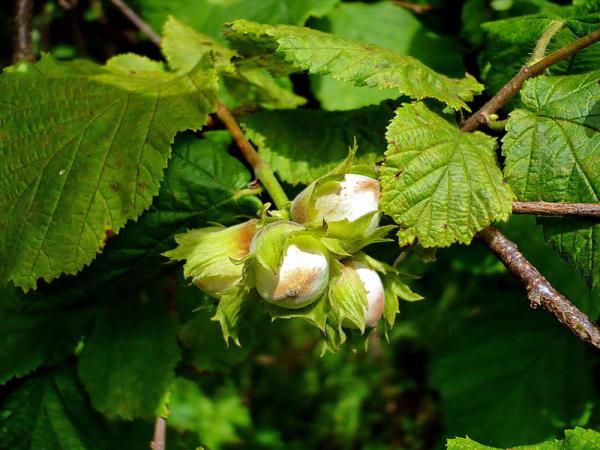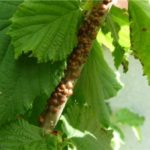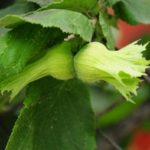Common hazel is a deciduous shrub reaching a height of up to 10 meters. Such the shrub has healing properties. Therefore, people called hazel hazel.
Table of contents
Description of Common Hazel
The plant belongs to the Hazel family. Hazel leaves are large, with jagged edges, red in the fall. Bark of a bush of brown color with cross strips.There is a powerful root system that grows very quickly deep in the soil.
After planting the shrub grows slowly, gradually increasing in growth. Flowering occurs before the leaves bloom, in early spring. On the trees, earrings are about long 5-7 cm, are single and assembled in several pieces together. The fruit is an oval-shaped nut, located in a green plyus. Ripening occurs at the end of summer. In stems can occur before 20 nutsbut more common 2-5 pieces. Shrub begins to fructify in 8 years. This shrub is a long-lived, its age reaches 100 years, it is frost-resistant.
In nature, hazel is found in Russia, in the Caucasus, in the Crimea. There are more than 10 types.
- Common Hazel
- Tree
- Large
- Manchu
- Diverse leaf
- Horned
Hazel treelike
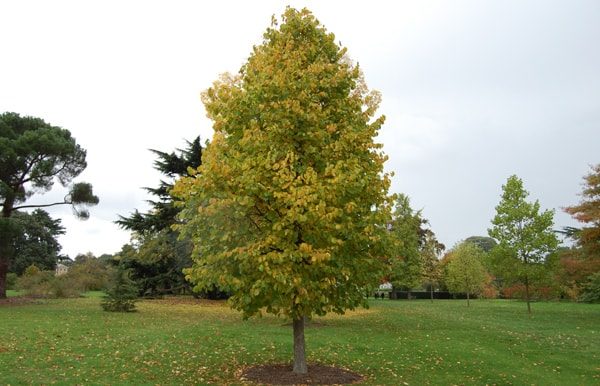
Received the name of a bear nut. Tree up to 20 meters in length, 8 meters wide. Bark of a bush has gray color and exfoliate by plates. It grows very slowly. In autumn, the leaves turn yellow.The fruits of the tree hazel are divided into sharp slices. The shrub is unpretentious, tolerates drought, adapts in any climate.
Lombard nut
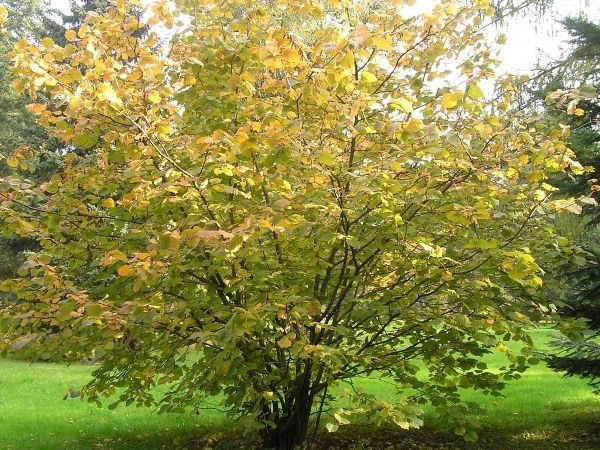
Shrub large hazel (Lombard nut) has grayish branches, up to 15 meters long. The leaves are large, toothed. It does not tolerate frosts. Often grown in the Balkans.
Leshchina Manchu
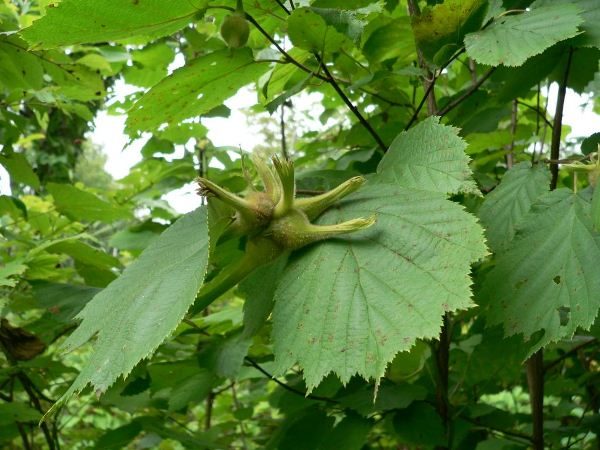
It is a shrub with many trunks, has a barrel length from 3 before 7 meters. The bark of hazel is brown, the leaves are rounded, have a dark green color. The fruits are oblong nuts. Shade-tolerant and frost-resistant. Found in Primorsky, Khabarovsk.
Hazel leaf
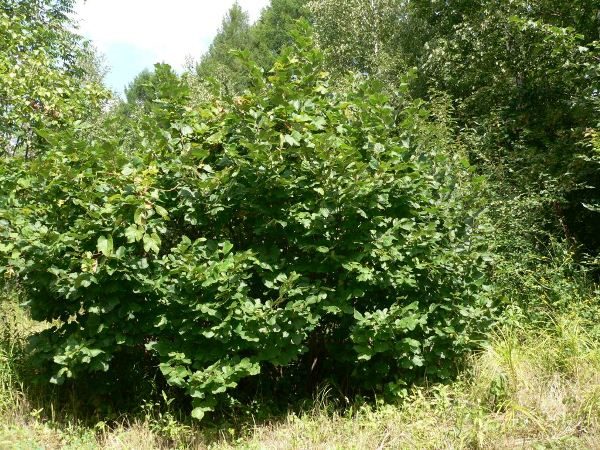
Very thick shrub up to 4 meters. Leaves change color. In the summer green, in the spring red, in the autumn yellow. Shrub loves light, can tolerate shade, frost-resistant, tolerates drought. Fruiting begins early. It grows in the Urals, the Far East and Siberia.
Horned hazel

It grows up to 3 meters in height. It has a lush crown and oval yellow leaves. Received the name due to the fruit resembling a horn.Growing in North America.
The composition and benefits of hazelnut
Hazelnut, which is called hazel, is the most common and favorite type of nut. Hazelnuts are considered valuable and tasty nuts., several times more nutritious than bread and dairy products.
The main mass of the fetus is formed by fats, one fifth of proteins and amino acids. The nut contains a huge number of minerals.:
- Potassium
- Phosphorus
- Magnesium
- Sodium
- Copper
- Iron
All the listed healing and healing properties fill the body with energy. Hazelnut oil contains acids that can protect the heart and blood vessels. For the growth and development of the body, the nut is useful for children, and the elderly to maintain strength and health.. In addition, hazelnuts are substances that can cleanse the body, remove toxins. Vitamins, prevent the appearance of cancer cells. Fruits, leaves, bark, roots are used for medicinal purposes. Hazel is a laxative, used for diarrhea. A decoction of the bark of the tree can serve as a remedy for varicose veins.
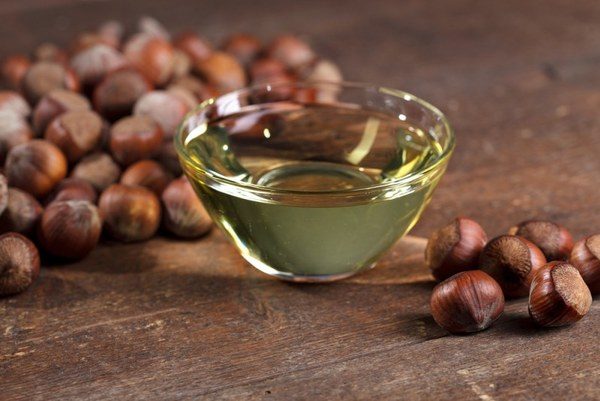
The use of hazelnuts in cooking is widespread.. Walnut is used in the preparation of various dishes, as well as in baking.
Preparations prepared on the basis of hazel, are used in cosmetology. Against hair loss use oil and a decoction of the leaves of the nut.
But, along with beneficial substances there are contraindications. It is necessary to eat a limited amount of nuts, otherwise it causes headache and allergic reactions.
Planting and tree care
With proper planting hazel need to choose a free, sunlit place. The tree grows well on any soil, does not like swampy and sandy areas. Before planting, it is necessary to prepare a place that will not flood the saplings when spring comes.
Favorable time for planting fall, but you can plant seedlings in the spring, until the end of April. The distance between the trees with the growth take into account at least five meters. For harvesting, it is necessary to plant three or more, inter-pollinated shrubs..
Before planting, you need to purchase a young sapling, you can dig it in the forest. Prepare a hole by digging with a spade 80 to 80 cm and in depth 80 cm. Humus, black soil, fertilizer is introduced into each pit and mixed with the ground. Around the seedlings to form a hole and pour water. After the mulching is done with sawdust or grass.
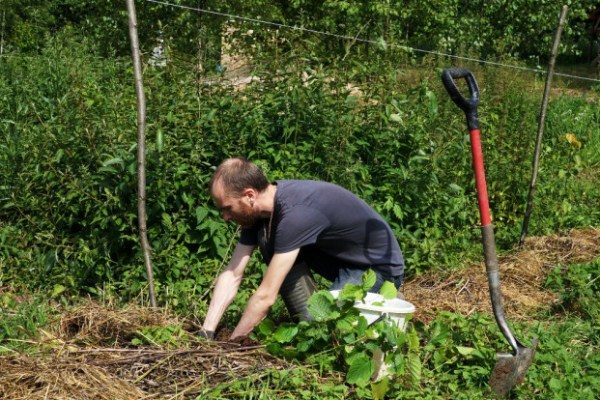
After planting, the young shrub needs to be watered, weeded, fed with fertilizers, treated from pests. After planting a young bush, it is necessary to loosen the soil and water it, especially in summer in hot weather. Adult tree care does not require much, you need to produce pruning for good fruiting. When buying, be careful of seedlings, seedlings, they bear fruit several years later, the nut is smaller in size. Hazel grows in mixed and coniferous forests, in the steppe, along the rivers. Hazel is widespread in Russia, the Caucasus, Europe, and the Primorsky Territory.
Rules of reproduction and cultivation
There are different ways of reproduction vegetative and seed. Seed method is used for growing seedlings. For sowing, ripe nuts are taken, sown immediately after harvest in September.
Varietal shrubs are propagated in a vegetative way:
- Layering
- Rhizomes
- Vaccinations
- The division of the bushes
- Cuttings
Reproduction by layering young shoots bend and root to the ground, not tearing from the bushes. Everything should be done with care, so as not to harm the kidneys, which will give young shoots.
Rhizome growth the plant appears in the third year after planting the seedlings. One shrub produces more than a hundred shoots, and they are used for reproduction. Three summer rhizomes are separated along the edges of the bush with an ax, spade or hacksaw. Sprouts have weak roots, they are planted in one hole for 3 pieces. And in nurseries they grow about 2 years to strengthen the root system.
Leshchina multiply and dividing the bush. The uprooted shrub is divided into several parts so that each stump has roots. After planting should be abundant watering, for a good engraftment of the bush. Already in the third year, these seedlings begin to bear fruit.
In order to propagate by grafting, cuttings are harvested from autumn, and stored in a cool place. The inoculation is done in the spring in the butt, in the split or behind the bark. Better graft vaccination for the cortex.Vaccinations smear with garden pitch and cover with foil. After bud break, the film is removed.
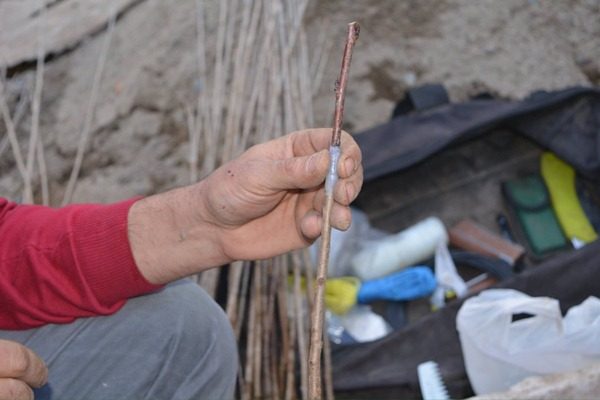
Hazel cuttings rooted in closed ground with high humidity. It is necessary to cut the saplings 10 centimeters long, remove the lower leaves. After that, prepare the composition of sand, peat, soil and humus. Planted cuttings in boxes with wet soil under the film. After 3 weeks, after the roots appear, the film is removed.
Harvesting
Harvesting hazel occurs in the third year, when the bush begins to bear fruit in September.
When shaking a tree, the nuts that are not fallen should be given time to ripen. Immediately after ripening, the nuts are not suitable for human consumption. They need to dry out for some time in a dry and ventilated room. Keep nuts recommended in bags through which air passes. When harvesting, the ground is heavily trampled under the shrub; it must be loosened, watered and fertilized after it.
Susceptibility to pests and diseases
Susceptibility to diseases and pests and diseases Hazel is rarely exposed. There are many shrub pests.:
- Aphid
- Shchitovka
- Weevil beetle
- Walnut Weevil
- Hazel damaged by shield
- Special damage to hazel does aphid
Damaged fruits caterpillars showered in large quantities. A dangerous pest is the weevil beetle. When spring comes, he eats the leaves, then lay eggs. A larva appears inside the nut, which gnaws out all the contents. In the fight against pests, it is necessary to spray the bushes after flowering with a solution of chlorophos or other drugs. Measures are being taken to clean the foliage and damaged nuts near the tree.
In gardens, it is still rare to find a magnificent and beautiful hazel tree, although the shrub is popular. The bush has many values in medicine, and wood is of particular value in furniture and industrial production.. In addition, the shrub is an object of beauty in any garden, especially during flowering.
